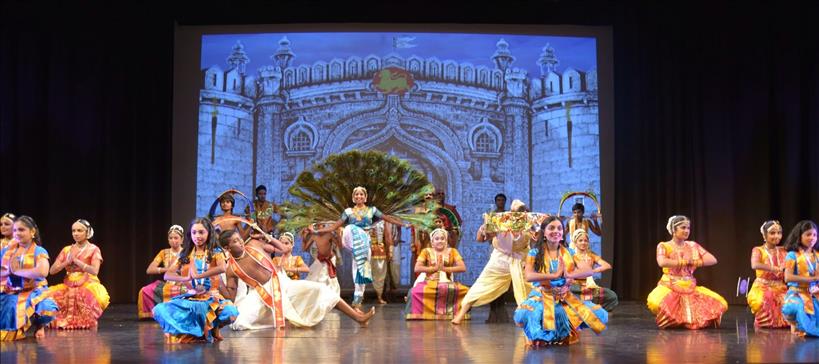Students of the Sai Natyalaya received a standing ovation at the Dorothy Winstone Centre of Auckland Girls Grammar School on Saturday, June 28, 2014 for their sparkling presentation of a dance drama.
‘Sivagamiyin Sabatham’ challenged their levels of endurance, ability to synchronise dance and lip movements to recorded music and dialogue and most importantly, relive an era that was marked by struggle for power, love of a Royal to a dancer, passion, war, and death- everything in fact that makes life worth living.
Entrancing youth
More than 50 students of the Natyalaya were involved with the massive production that has already had audiences in India and the US in a spell.
Madurai R Muralidharan, a Bharata Natyam master for bringing to life one of the masterpieces of the late journalist and writer ‘Kalki,’ whose ‘Sivagamiyin Sabatham’ was published in a series in the magazine bearing his name.
Synergy and proficiency
Muralidharan deserves credit for classy dialogues, choreography (the original was choreographed by his wife Chitra), music and the overall ability to teach young students their movements in a remarkably short time of less than 10 days.
Renuka Ketheesan, Director and Principal of Sai Natyalaya also deserves credit and accolades for training her students and preparing them for final rehearsals.
It was a programme replete with rhythm, superb coordination and proficient dancing.
Dance dramas depicting historic events usually have the benefit of exquisite and elaborate settings, special effects and live music.
‘Sivagamiyin Sabatham’ had none of these. Symbolism was the thumb rule of the Dance Drama, with much of the action left to the imagination of the performers. The slide show, which formed the backdrop, was helpful in creating the Seventh Century South India.

Artistic liberty
Playwrights, directors and creative people in general exercise their liberty to stray a bit from the originals of classics to give a dramatic effect and add relevance of the modern times. Muralidharan did exactly that- to alter the sequence of narration.
Yet, there was plenty of room for proper characterisation- Sivagami’s pride and ambition, Naganandi’s all-encompassing love for Sivagami’s art that slowly turns carnal, Aayanar’s obsessions with the secret of the Ajanta cave paintings, to mention a few.
The Narration
The Dance Drama begins with Aayanar Chirpi (Ratna Venkat) lamenting the abduction of his daughter Sivagami (Sindhuja Mohanraj), recollecting the happy days in a short flashback. Then followed another long flashback when Narasimha Pallava (Kaviya Balaraman) recollects his childhood romance with Sivagami in a conversation with his wife (Alexshana Sivarajah) just before he leaves for the war in Vatapi.
From thereon, the action moves forward to Sivagami’s incarceration in Vatapi, the bloody war, Narasimha Pallava’s victory procession with his family and ends with Sivagami (portrayed by Vethahi Arunthayaparan) surrendering to Lord Ekambareswarar.
Superb teamwork
‘Sivagamiyin Sabatham’ belonged to every participant, many of who had an opportunity to give vent to their level of talent in Bharata Natyam. The ‘Kavadi Dance’ was a clever addition to bring out the essence of artistry.
Muralidharan played the dual roles of Naganandi and his twin brother Emperor Pulikesi II, and their conversation on a moonlit night was achieved with Naganandi standing within the conical rays of a spotlight and Pulikesi in a pre-recorded conversation projected on the back.
The Dance Drama was an excellent essay that brought out one of the most poignant chapters of a Kingdom in which art thrived with romance, only to be destroyed by the platonic love of Naganandini. I suppose that the tragic ending brought purity to the character of Sivagami, for, history would not have been kind if she had decided otherwise.
Pictures for Indian Newslink by Ilango Krishnamoorthy






